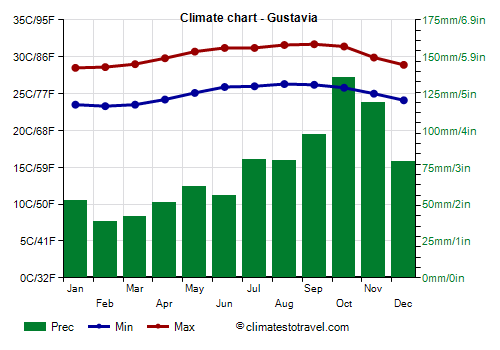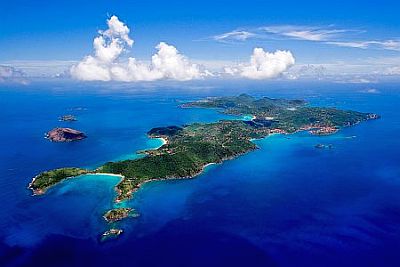Select units of measurement for the temperature and rainfall tables (metric or imperial).
Average weather, temperature, rainfall, sunshine
In Saint-Barthélemy, the climate is
tropical, hot all year round, with a relatively cool season from December to April, called "the Lent", and a hot and humid season from May to November, called "the Wintering". Despite the name, the latter is a sultry period, characterized by many sunshine hours, but also by showers or thunderstorms, especially in the afternoon.
Saint-Barthélemy (also known as Saint-Barth or St. Barts) is a small island, which was part of the French overseas department of Guadeloupe before 2007, while it used to be an overseas territory of France before 2003.
Because of the lack of mountains and rivers, there is a certain shortage of water available, so the water is collected from the rain, desalinated from the sea, or obtained from incinerators.
The climate in detail
Temperature and rain
Gustavia

In the capital,
Gustavia, the temperature varies little throughout the year: lows vary from 23.3 °C (73.9 °F) in February to 26.3 °C (79.3 °F) in August, and highs from 28.5 °C (83.3 °F) in January to 31.7 °C (89 °F) in September. In the hot and muggy period, however, sea breezes temper the heat.
Precipitation is not abundant, since it amounts to about 900 millimeters (35.5 inches) per year. In the wettest months, from September to November, from 95 to 135 mm (3.7 to 5.3 in) of rain fall per month. From January to April, the driest period, the rainfall hovers around 40/50 mm (1.6/2 in) per month.
The amount of
sunshine is good in all seasons, since the rains are usually intense but short-lived, so the sun often shines throughout the year. On average, there are around 3,000 hours of sunshine per year.

Sea temperature
In Saint-Barthélemy, as generally happens in the Lesser Antilles, you can swim all year round, in fact the water temperature varies from 26 °C (79 °F) in February and March, to 29 °C (84 °F) in September and October.
Hurricanes
From June to November, in Saint-Barthélemy as in all the Caribbean, there is the danger of tropical storms and
hurricanes, which, however, are more likely from August to October.
When to go
The best period to visit Saint-Barthélemy runs from
January to April, since it is the least hot and the least rainy period of the year. The driest months are February and March.
In May, both temperature and moisture increase, but the rains are still not too abundant, and we are still out of the hurricane season.
In June and July, we are, by now, in the hot and muggy season, although the rains are less frequent than in August and September, and hurricanes are less likely to occur.
What to pack
All year round: bring
light clothes of natural fabric; possibly a light sweatshirt and a light raincoat for thunderstorms, especially from August to December. From December to March, you can add a light sweatshirt for the evening.
When going to the reef, you can bring snorkeling equipment, including water shoes or rubber-soled shoes.
Climate data - Saint Barthelemy
| Gustavia |
|---|
|
| Jan | Feb | Mar | Apr | May | Jun | Jul | Aug | Sep | Oct | Nov | Dec |
|---|
| Min temp. | 24 | 23 | 24 | 24 | 25 | 26 | 26 | 26 | 26 | 26 | 25 | 24 |
|---|
| Max temp. | 28 | 29 | 29 | 30 | 31 | 31 | 31 | 32 | 32 | 31 | 30 | 29 |
|---|
| Precip. | 55 | 40 | 40 | 50 | 60 | 55 | 80 | 80 | 95 | 135 | 120 | 80 |
|---|
| Prec. days | 12 | 10 | 8 | 8 | 10 | 9 | 12 | 13 | 11 | 12 | 14 | 13 |
|---|
|
| Day length | 11 | 12 | 12 | 13 | 13 | 13 | 13 | 13 | 12 | 12 | 11 | 11 |
|---|
| Sun hours | 8 | 8 | 9 | 9 | 8 | 8 | 8 | 9 | 8 | 8 | 8 | 8 |
|---|
| Sea temp | 26 | 26 | 26 | 27 | 27 | 28 | 28 | 29 | 29 | 29 | 28 | 27 |
|---|